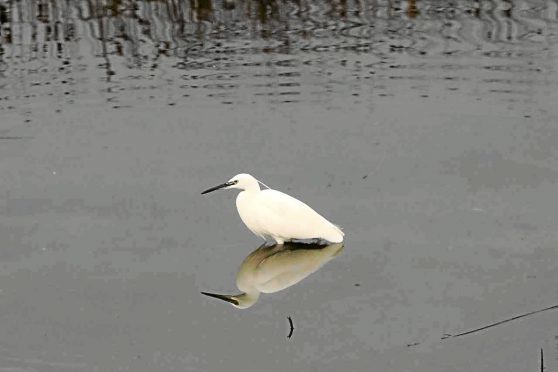You may remember what a lovely morning Monday was. Inka and I went out soon after 8.30 and were greeted by a spectacular winter’s scene – the ground iron hard and the grass white with frost.
The temperature gauge in the car showed -8°C, which seemed positively Mediterranean – a month ago, staying with friends at Old Bridge of Tilt, near Blair Atholl, we had woken to a temperature of -13°C.
There wasn’t a breath of wind to so much as shiver the topmost branches of the trees or the grasses at the burn side. The sunrise to the east welcomed in the day with brushstrokes of pink and dove-grey cloud on a cornflower blue sky, reflected on the snow-topped hills at the back of the village. To the west, the waning half moon gently dipped out of sight behind the Glenesk hills.
Memorable walk
Inka regains his lost youth in these conditions and I decided to head for Montrose Basin, the great tidal estuary that takes its name from the town, and the walk up the River South Esk from the historic old jetty at Old Montrose. I should walk there more often as there are 360° views all the way and endless interest.
To the east, the Auld Kirk steeple in the middle of the town dominates Montrose’s skyline from whatever direction you look. I used to collect old prints of the town and it is the single most recognisable feature in all of them. Westwards, the eye is carried to the amphitheatre of the foothills of the Grampian Mountains.
The tide was out, almost on the turn, as we took the track along the sea wall that protects the low-lying fields on the other side from flooding. Ice had formed above the low water mark and, despite some warmth from the sun, it was nippy on the tips of my nose and ears.
Many of the geese that arrived in October have dispersed but a pack of pinkfoot flew over us. On my short walk I met a friendly robin and saw redshank, mallard, wigeon, eider duck, mute swans and gorgeously handsome shelduck. The haunting, bleak winter cries of whaups (curlews) carried on the still air.
A black rabbit – a parson, my father would have called it – probably disturbed by Inka, burst out of the whins, saw me and shot back into the cover again.
White settlers
Changes in weather patterns from global warming have brought unexpected visitors to The Basin, which hitherto was too cold for them.
A ditch on the landward side of the sea wall takes drainage from the fields. A hundred yards ahead of me a pure white bird that I didn’t recognise, but was reminiscent of a heron, was fishing – its back to me. With Inka firmly into heel, I hoped I could creep close enough to get a photograph.
Despite my best efforts it heard me and took to the air. I saw where it landed and tried to stalk it again but it was too wary and took flight once more. Another birder, with telescope and camera, came up the track and greeted me: “It’s the Man with Two Dogs”. We got talking – we’d met before on the ice rink, curling – the britherhood of the ice. He had been coming to The Basin for 40 years to watch the changing birdlife scene over the seasons. He reckoned the bird I had seen was a little egret, one of four that have taken up residence on the local nature reserve. It was a first for me, as I have always associated them with the hot climates of France and the Mediterranean.
On the far bank, where the river runs into The Basin, are areas of reed beds and mud known as the Slunks and the Lurgies. I consulted my Dr Jamieson’s Etymological Dictionary of the Scottish Language to find the derivation of the two words.
A slunk is a quagmire, just what the Slunks are when the tide is out and the mud is exposed. The meaning of Lurgies seems lost in the mists of history but, then, there have always been things that drop out of the ken of man.
Yellow petals
Even in the depths of winter, you will always find some blossom on the whin, or gorse, bushes which gave rise to the old Scottish adage: Ye canna kiss the lassies when the when the whin is not in bloom. Well, I saw plenty yellow whin blossom on my walk – enough, certainly, to at least beg a peck on the cheek!
The Basin’s history goes back far beyond the Romans who established a camp at today’s Gilrivie Farm to supply their army, which defeated the Caledonian forces at the battle of Mons Graupius in AD 83.










